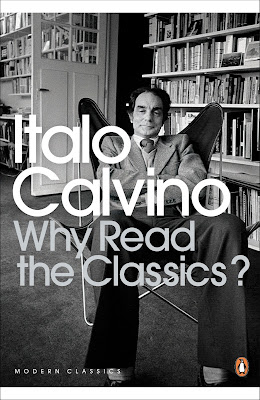by Maria Popova
“A classic is a work which constantly generates a pulviscular cloud of
critical discourse around it, but which always shakes the particles off.”
A reader recently wrote me
to lightly criticize the fact that I called George Orwell’s Animal Farm and Nineteen Eighty-Four “cult-classics,”
suggesting that they instead merit the inferior term “required reading.” So
what, exactly, is a classic, and why should we care? Richard J. Smith, in
discussing the iconic ancient ChineseBook of Changes, offered a four-point checklist definition and Simon Crtichley showed us how to read them. But perhaps the most essential question is why the classics should be
read. That’s exactly what beloved Italian writer Italo Calvino addresses in his 1991 book Why Read the Classics? (public library) — a sort of “classic” in
its own right. In this collection of essays on classical literature, Calvino
also produces these 14 definitions of a “classic”:
1.
The classics are those books about which you
usually hear people saying: 'I'm rereading…', never 'I'm reading….'
2.
The Classics are those books which constitute a
treasured experience for those who have read and loved them; but they remain
just as rich an experience for those who reserve the chance to read them for
when they are in the best condition to enjoy them.
3.
The classics are books which exercise a particular
influence, both when they imprint themselves on our imagination as
unforgettable, and when they hide in the layers of memory disguised as the
individual's or the collective unconscious.
4.
A classic is a book which with each rereading
offers as much of a sense of discovery as the first reading.
5.
A classic is a book which even when we read it for
the first time gives the sense of rereading something we have read before.
6.
A classic is a book which has never exhausted all
it has to say to its readers.
7.
The classics are those books which come to us
bearing the aura of previous interpretations, and trailing behind them the
traces they have left in the culture or cultures (or just in the languages and
customs) through which they have passed.
8.
A classic is a work which constantly generates a
pulviscular cloud of critical discourse around it, but which always shakes the
particles off.
9.
Classics are books which, the more we think we know
them through hearsay, the more original, unexpected, and innovative we find
them when we actually read them.
10.
A classic is the term given to any book which comes
to represent the whole universe, a book on a par with ancient talismans.
11.
'Your' classic is a book to which you cannot remain
indifferent, and which helps you define yourself in relation or even in
opposition to it.
12.
A classic is a work that comes before other
classics; but those who have read other classics first immediately recognize
its place in the genealogy of classic works.
13.
A classic is a work which relegates the noise of
the present to a background hum, which at the same time the classics cannot
exist without.
14.
A classic is a work which persists as a background
noise even when a present that is totally incompatible with it holds sway.
Perhaps most poetic is Calvino’s 11th definition, bespeaking the idea
that there is room for subjectivity even in a term as deterministically
universal as a “classic,” and offering a witty answer to the nitpicky reader: “‘Your’ classic is a book to which you cannot remain indifferent,
and which helps you define yourself in relation or even in opposition to it.”

















Nenhum comentário:
Postar um comentário